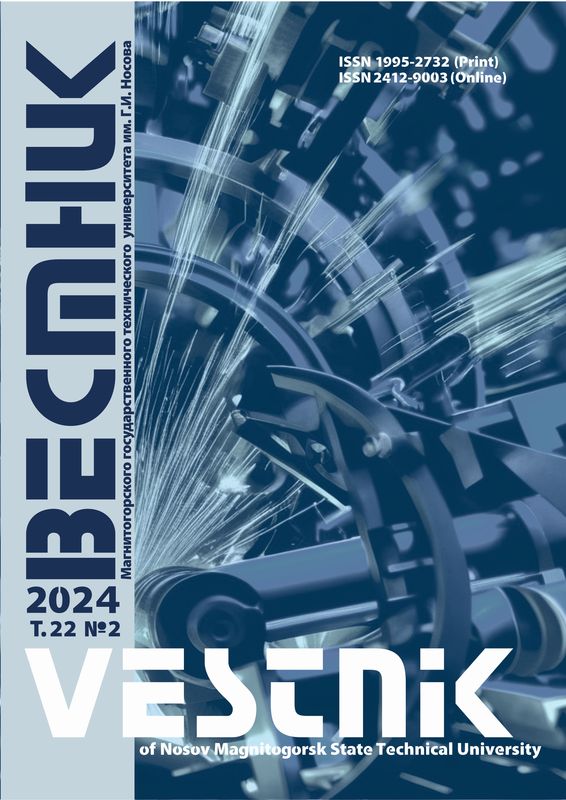DOI: 10.18503/1995-2732-2024-22-2-163-169
Abstract
In the modern world, with the development of digital technologies, companies need to maintain a sufficient level of competitiveness to remain relevant in the market. Therefore, a crucial task for every enterprise is to improve their processes to enhance the product quality and reduce production waste. One of the tools of the upcoming digitalization is additive manufacturing, which, unlike subtractive manufacturing, provides for greater customization and lower labor costs. The aim of this study is to explore the possibility of integrating a digital twin into the additive manufacturing process to enhance the quality of the produced goods. Quality assurance is one of the key tasks in additive manufacturing. Measures for quality assurance in the production process and, particularly, the inspection of the quality of finished parts, require a significant amount of time and resources. Most existing approaches to quality assurance have been developed for conventional manufacturing methods such as milling or turning and have been optimized over time. However, these approaches are not easily applicable to additive manufacturing due to unique characteristics of the process. Originality lies in developing the concept of part virtual control based on the digital twin in additive manufacturing. As a result, the article presents an approach to part virtual control based on the digital twin in additive manufacturing, describes the concept of the digital twin, and defines a usage scenario for ensuring the product quality. The concept under study can be used as one of the possible solutions for implementing a holistic approach to quality assurance throughout the technological chain of additive manufacturing.
Keywords
digital transformation, Industry 4.0, 3D printing, additive technology, digital twin
For citation
Khomyakov N.V. A Concept of Part Quality Virtual Control in Additive Manufacturing Based on a Digital Twin. Vestnik Magnitogorskogo Gosudarstvennogo Tekhnicheskogo Universiteta im. G.I. Nosova [Vestnik of Nosov Magnitogorsk State Technical University]. 2024, vol. 22, no. 2, pp. 163-169. https://doi.org/10.18503/1995-2732-2024-22-2-163-169
1. Egorov K.N., Egorova S.A., Petryakova V.G. Additive technologies in medicine: areas and technologies of application, advantages, disadvantages and development prospects. Perspektivy razvitiya nauki v sovremennom mire: sbornik nauchnykh statey po materialam VI Mezhdunarodnoy nauchno-prakticheskoy konferentsii [Prospects for the development of science in the modern world: Collection of scientific articles based on proceedings of the 6th International Scientific and Practical Conference]. Ufa, June 29, 2021. Ufa: LLC Scientific Publishing Center Bulletin of Science, 2021, pp. 21-41. (In Russ.)
2. Speshilova N.V., Andrienko D.A., Rakhmatullin R.R., Speshilov E.A. Trends in the development of the Russian economy against the backdrop of global trends in the conditions of the fourth industrial revolution. Vestnik evraziyskoy nauki [Eurasian Scientific Journal]. 2018;10(6):44. (In Russ.)
3. Bochkareva A.V. 3D technologies in the educational field of higher educational institutions. European Scientific Conference: collection of articles of the 5th International Scientific and Practical Conference. Part 3. Penza, July 30, 2017: in 3 parts, part 3. Penza: Science and Enlightenment (Individual Entrepreneur Gulyaev G.Yu.), 2017, pp. 169-171. (In Russ.)
4. Eroshenko V.O., Malkova M.Yu., Zadiranov A.N., Meshcheryakov A.V. Development of a model for printing turbine blades on a 3D printer. Vestnik Magnitogorskogo gosudarstvennogo tekhnicheskogo universiteta im. G.I. Nosova [Vestnik of Nosov Magnitogorsk State Technical University]. 2023;21(1):82-92. (In Russ.) DOI: 10.18503/1995-2732-2023-21-1-82-92
5. Zagidullin R.S., Mitroshkina T.A., Sadykov O.F., et al. Development of a quality assurance model in designing, manufacturing, testing of aerospace technology products. Izvestiya Tulskogo gosudarstvennogo universiteta. Tekhnicheskiye nauki [News of Tula State University. Technical Sciences]. 2019;(12):27-33. (In Russ.)
6. Nationale Akademie der Wissenschaften Leopoldina, Union der deutschen Akademien der Wissenschaften, acatech – Deutsche Akademie der Technikwissenschaften. Additive Fertigung – Entwicklungen, Möglichkeiten und Herausforderungen: Stellungnahme (Additive manufacturing – developments, opportunities and challenges: Position statement). Halle (Saale), München, Mainz, 2020.
7. Bamberg J., Dusel K.-H., Satzger W. Overview of additive manufacturing activities at MTU aero engines. AIP Conference Proceedings. 2015;1650(1):156-163.
8. Kerstin Winkler, Husam Ahmad, Andre Danzig, Philipp Gloetter, Frank Schubert, Guntram Wagner, Lothar Kroll. Effect of organic impurity in additive manufactured Ti-6Al-4V. Additive Manufacturing Letters. 2023;5:100-116. https://doi.org/10.1016/ j.addlet.2022.100116
9. DIN SPEC 17071:2019-12. Additive Fertigung – Anforderungen an qualitätsgesicherte Prozesse für additive Fertigungszentren (Additive manufacturing – Requirements for quality assured processes at additive manufacturing centres). Text in German and English. Berlin: Beuth Verlag GmbH, 2019, 59 p. DOI: 10.31030/3119149
10. Stark R., Anderl R., Thoben K.-D., Wartzack S. WiGeP-Positionspapier: «Digitaler Zwilling» (WiGeP Position Paper: "Digital Twin"). ZWF. 2020;(115(special)):47-50.
11. Kuznetsova S.V., Semenov A.S. Digital twins in the aerospace industry: an object-oriented approach. Trudy MAI [Proceedings of Moscow Aviation Institute]. 2023;(131):430-432. (In Russ.)
12. Khomyakov N.V. Lean 4.0. Impact of Industry 4.0 tools on lean manufacturing. Vestnik Sankt-Peterburgskogo universiteta tekhnologii i dizayna. Seriya 4: Promyshlennye tekhnologii [Vestnik of Saint Petersburg University of Technology and Design. Series 4: Industrial Technologies]. 2023;(3):68-75. (In Russ.)
13. DebRoy T., Zhang W., Turner J., Babu SS. Building digital twins of 3D printing machines. Scripta Materialia. 2017;135:119-124.
14. Bezrukikh D.I., Chernyshova Yu.A. Application of digital twin technology and additive technologies in the development of rocket engines. Molodye uchenye v reshenii aktualnykh problem nauki: sbornik materialov Vserossiyskoy nauchno-prakticheskoy konferentsii studentov, aspirantov i molodykh uchenykh [Young scientists in solving current problems of science: Proceedings of the All-Russian Scientific and Practical Conference of Students, Postgraduate Students and Young Scientists]. Krasnoyarsk, April 20-21, 2023. Krasnoyarsk, 2023, pp. 1436-1438. (In Russ.)
15. Anderl R., Haag S., Schützer K., Zancul E. Digital twin technology – An approach for Industrie 4.0 vertical and horizontal lifecycle integration. Information Technology. 2018;(60(3)):125-132.












